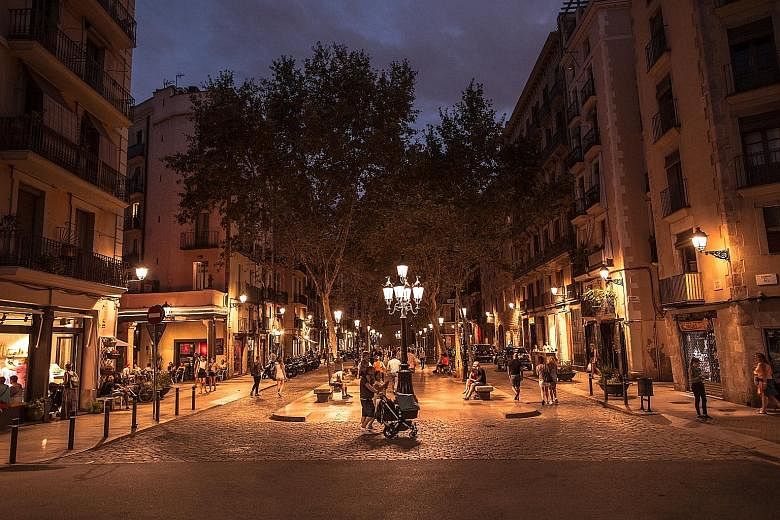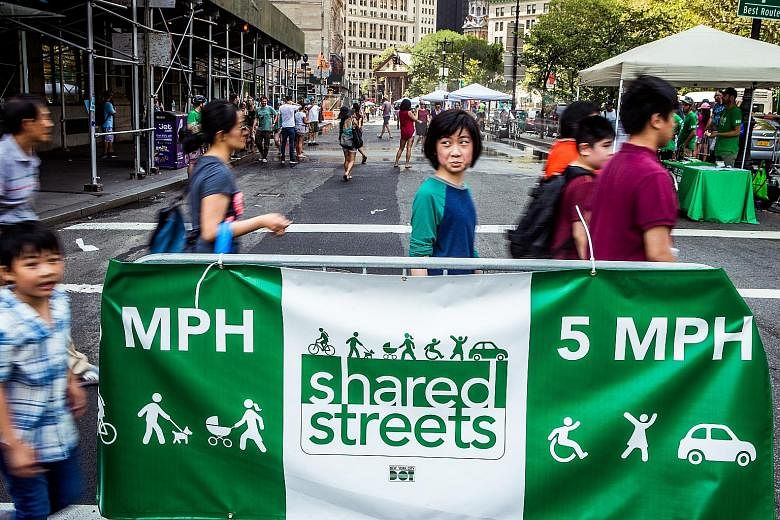BARCELONA (Spain) • Imagine if streets were for strolling, intersections were for playing and cars were seldom allowed.
While it sounds like a pedestrian's daydream, and a driver's nightmare, this is becoming a reality in Spain's second-largest city, a densely packed metropolis of 1.6 million.
Ever since the 1992 Summer Olympics focused global attention on Barcelona, this thriving centre of tourism, culture and business - often viewed as a hipper, more easy-going cousin to Madrid, the Spanish capital - has seen its popularity soar along with congestion on streets and sidewalks.
So in an initiative that has drawn international attention and represents a transformative remaking of its streetscape, Barcelona has decided that many of its car-clogged streets and intersections will hardly have cars at all. Instead, they will be turned over to pedestrians.
Last month, city officials started creating a system of so-called superblocks across the city that will severely limit vehicles, so as to reduce traffic and air pollution, use public space more efficiently and make neighbourhoods more pleasant.
Said Barcelona's deputy mayor Janet Sanz Cid: "People from Barcelona want to use the streets, but right now they can't because they are occupied by cars."
Under the plan, the superblocks will be overlaid on the existing street grid, each one consisting of as many as nine contiguous blocks. Within each superblock, streets and intersections will be largely closed to traffic and used as community spaces such as plazas, playgrounds and gardens.
While spaces like pedestrian plazas have created more room for pedestrians in busy corridors, superblocks represent a more radical approach that challenges the notion that streets belong to cars.
This has propelled Barcelona, a city better known for its soccer team and its Gaudí architecture, to the forefront of urban transportation experiments, attracting interest from transportation officials, urban planners and advocates in many other cities paralysed by gridlock.
Barcelona's plan will redirect cars, buses and commercial vehicles to streets along the perimeter of each superblock, though local residents will still be able to drive their cars at reduced speeds and park in designated areas. Deliveries will be allowed at less congested times.
To be widely accepted, however, the plan requires a cultural shift in the way people view and use the streets.
The first of the new superblocks received a mixed reaction when it was unveiled recently in El Poblenou, a former industrial area that has been redeveloped with low-income housing and offices for technology companies. Many residents saw the benefits of the superblock, but some complained that they were not given enough time or explanation before it was put in place.
Businesses expressed concern that it could interfere with their work by restricting when they can load and unload goods.
In Barcelona, the superblock is not a new idea. The first one was introduced in 1993 in the El Born neighbourhood in the city centre. Two more followed in 2005 in Gràcia, a northern neighbourhood known for its plazas and narrow streets.
But superblocks did not become a priority until housing activist Ada Colau was elected mayor last year. Ms Sanz noted that instead of focusing on big commercial developments favoured under previous city planning policies, the current administration was interested in "concrete, precise interventions" to directly benefit residents.
NYTIMES


